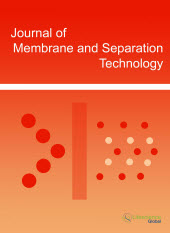jmst
Abstract : Zeolite A-Carbon Membranes: Possibilities in H2 Purification and how to Overcome their Shortcomings
|
|
Abstract: This work describes the modification of zeolite Na-LTA membranes supported on macroporous carbon materials, prepared by a combination of secondary hydrothermal treatment followed by different alternative post-synthesis procedures, which aim at improving the permeance properties of the as-synthesized Na-LTA membranes with a simulated reformer mixture (H2, CO, CO2 and H2O) towards their use in a hydrogen purification device.These post-synthetic treatments include the deposition of a thin layer of amorphous silica formed by the hydrolysis of a silicon alcoxide, the coating with a thin metallic film by electroless plating, and the deposition of noble metal nanoparticles. Our results indicate that some of these treatments, which may be performed very quickly compared to other treatments which are generally used in order to improve the quality of the membranes, result in membranes which may effectively separate H2 from CO under simulated reformer conditions. Considering the simple approach employed in some of the cases described in this study, the potential benefits should be considered highly interesting in fields such as membrane recovery and membrane selectivity control. Keywords: Zeolite, membranes, hydrogen purification, fuel cells.Download Full Article |
Abstract : Separation Enhancement of Mechanical Filters by Adding Negative Air Ions
|
|
Abstract: The purpose of this work is to combine negative air ions (NAIs)and mechanical filters for removal of indoor suspended particulates. Various factors, including aerosol size (0.05-0.45 μm), face velocity (10 and 20 cm/s), species of aerosol (potassium chloride and dioctyl phthalate), relative humidity (30% and 70%), and concentrations of NAIs (2 ´ 104, 1 ´ 105, and 2 ´ 105 NAIs/cm3) were considered to evaluate their effects on the aerosol collection characteristics of filters.Results show that the aerosol penetration through the mechanical filter is higher than that through the mechanical filters cooperated with NAIs. This finding implies that the aerosol removal efficiency of mechanical filters can be improved by NAIs. Furthermore, the aerosol penetration through the mechanical filters increased with the aerosol size when NAIs were added. That is due to that the aerosol is easier to be charged when its size gets larger.The results also indicate the aerosol penetration decreased with the NAIs concentration increased. Reversely, aerosol penetration through the mechanical filters increased with the face velocity under the influence of NAIs. The aerosol penetration through the filter with NAIs was no affected with relative humidity. Finally, The penetration through the filter with NAIs against solid aerosol was lower than that against liquid aerosol. Keywords: Negative air ions, Filtration, Aerosol penetration, Mechanical filter..Download Full Article |
Abstract : Response Surface Optimization of Electro-Spun Polyvinyl Alcohol Nano-Fiber Membrane Process Parameters and its Characterization
|
|
Abstract: An empirical exploration into the effects of time duration, voltage supply, concentration and flow rate on the membrane average fiber diameter and surface pore size distribution were done using response surface methodology (RSM) based on central compact design (CCD). The average fiber diameter and average surface pore diameter of the membrane (i.e. 110 nm and 130 nm, respectively) were obtained at optimum input parameters of 45 min, 10 wt. %, 12 kV and 1.0 mL/h for time duration, concentration, voltage supply, and flow rate, respectively. The optimization study shows that the predicted versus actual values of both membrane fiber diameter and surface pore diameter are at R2 = 0.96. In addition, the effect of glutaraldehyde on membrane crosslinking was also assessed for further studies. The results from FESEM images of the fabricated PVA nanofiber membranes using the optimized parameters revealed that the membranes showed smooth morphological structures without formation of beads. The thermo gravimetric analysis (TGA) results displayed an improvement in thermal stability after membrane crosslinking. From this study we have observed that the membrane average fiber diameter and surface pore diameter can be controlled by varying the electro-spinning parameters and can be utilized for wastewater treatment application. Keywords: Electro-spinning, RSM, Crosslinking, PVA, Thermal analysis.Download Full Article |
Abstract : Simulation of Recovery of Aroma Compound from Aqueous Solutions by Batch Pervaporation Coupled with Permeate Decantation and Water Phase Recycle
|
|
Abstract: In this work, the dynamic (batch) models of recovery of low soluble aroma compounds from aqueous solutions by pervaporation coupled with permeate decantation and water phase recycle was derived and simulated. The model was run to simulate the pervaporation of propyl propionate-water separation using PEBA membrane. The effect of two parametric models (i.e. ratio of feed mass over membrane area (F0/Am) and the aroma solubility in water) on the aroma compound recovery was studied. As compared to the conventional pervaporation, the application of water phase recycle was known to be able to enhance the recovery of aroma compounds in various extents, depending on the operating time and aroma solubility. The larger membrane area used (or smaller (F0/Am)) did not affect the maximum aroma compound recovery, but only shortened the operating time. For the aroma solubility of 0.56, 1, and 5 wt.%, referring to the optimum operating time in the conventional mode, the extent of improvement in recovery can be around 7, 10 and 16%, respectively. The modified pervaporation process also offered another advantage that the process would not be strictly restricted by the operating time due to permanent increase in cumulative mass of aroma compound recovered in the product. Keywords: Dynamic model, aroma compound recovery, pervaporation, permeate decantation, water phase recycle.Download Full Article |






















